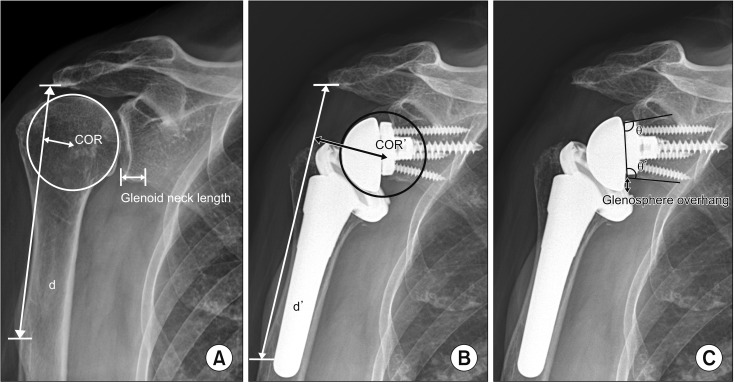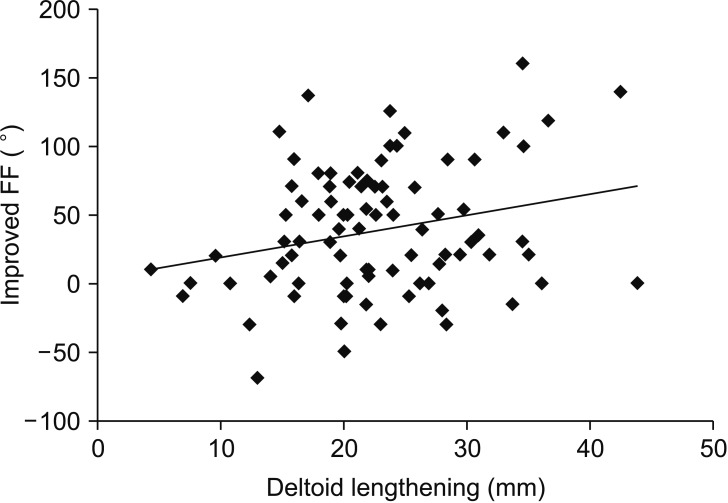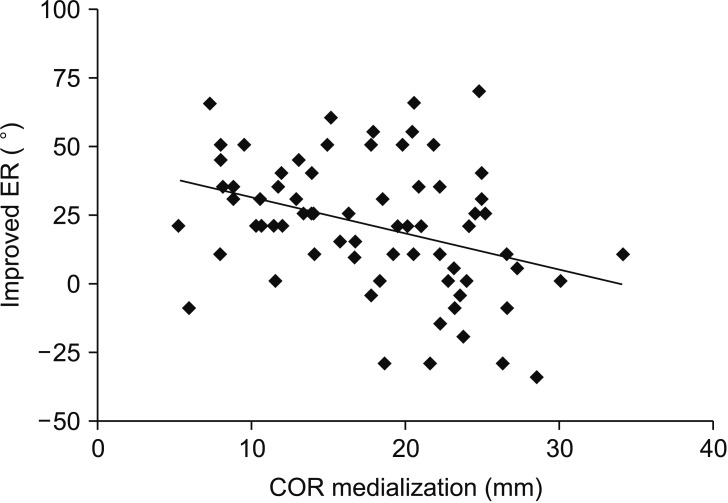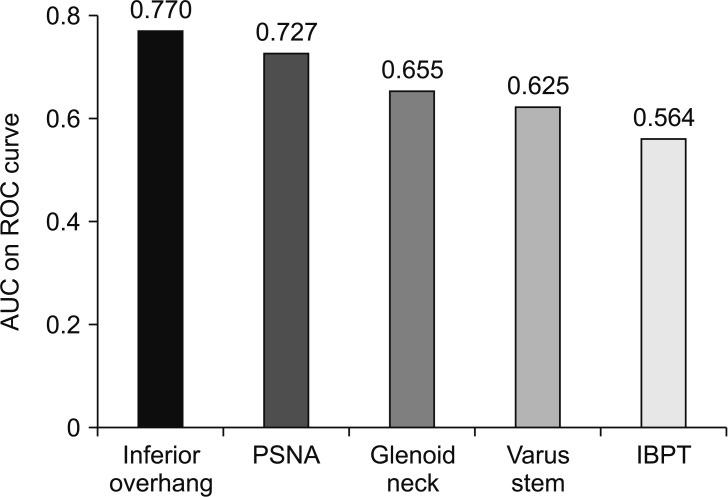Clin Orthop Surg.
2019 Mar;11(1):112-119. 10.4055/cios.2019.11.1.112.
Prognostic Radiological Factors Affecting Clinical Outcomes of Reverse Shoulder Arthroplasty in the Korean Population
- Affiliations
-
- 1Department of Orthopedic Surgery, Seoul National University Bundang Hospital, Seoul National University College of Medicine, Seongnam, Korea. ohjh1@snu.ac.kr
- 2Department of Orthopedic Surgery, Soonchunhyang University Bucheon Hospital, Soonchunhyang University School of Medicine, Bucheon, Korea.
- 3Department of Orthopedic Surgery, Samsung Medical Center, Sungkyunkwan University School of Medicine, Seoul, Korea. shoulderyoo@gmail.com
- KMID: 2438341
- DOI: http://doi.org/10.4055/cios.2019.11.1.112
Abstract
- BACKGROUND
Despite the growing use of reverse shoulder arthroplasty (RSA), it is associated with relatively frequent complications and uncertain clinical outcomes. We investigated radiological factors affecting clinical outcomes of RSA in the Korean population.
METHODS
We evaluated physical findings, radiographic findings, visual analog scale scores for pain and satisfaction, and several functional scores in 179 consecutive patients who underwent RSA at two centers between 2008 and 2014.
RESULTS
In 146 included RSAs, pain and forward flexion improved with deltoid lengthening (average, 23.5 ± 9.1 mm; p = 0.039). External rotation decreased with medialization (average, 16.8 ± 6.0 mm, p = 0.025), whereas internal rotation showed no correlation with humeral retroversion. Scapular notching (n = 44, 30%) significantly decreased with greater inferior glenosphere overhang (average, 2.94 ± 3.0 mm; p = 0.001), greater prosthesis scapular neck angle (average, 104°± 10.3°; p = 0.001), greater glenoid neck length (average, 9.8 ± 2.54 mm; p = 0.012), lower inferior baseplate tilt angle (average, 105.5°± 9.2°; p = 0.009), and varus humeral neck-shaft angle (p = 0.046), and it did not affect ranges of motion and pain, satisfaction, and functional scores. At the final follow-up, medialization was related to improvement in pain and satisfaction, and inferior glenosphere overhang to functional scores.
CONCLUSIONS
Proper amount of deltoid lengthening (mean, 2.3 cm) and inferior glenosphere overhang (mean, 2.9 mm) should be chosen for the better outcomes, while the center of rotation should be individualized according to patient characteristics in the Korean population.
Keyword
MeSH Terms
Figure
Reference
-
1. Boileau P, Watkinson D, Hatzidakis AM, Hovorka I. Neer Award 2005: the Grammont reverse shoulder prosthesis: results in cuff tear arthritis, fracture sequelae, and revision arthroplasty. J Shoulder Elbow Surg. 2006; 15(5):527–540. PMID: 16979046.
Article2. Guery J, Favard L, Sirveaux F, Oudet D, Mole D, Walch G. Reverse total shoulder arthroplasty: survivorship analysis of eighty replacements followed for five to ten years. J Bone Joint Surg Am. 2006; 88(8):1742–1747. PMID: 16882896.3. Ernstbrunner L, Suter A, Catanzaro S, Rahm S, Gerber C. Reverse total shoulder arthroplasty for massive, irreparable rotator cuff tears before the age of 60 years: long-term results. J Bone Joint Surg Am. 2017; 99(20):1721–1729. PMID: 29040126.4. Gerber C, Canonica S, Catanzaro S, Ernstbrunner L. Longitudinal observational study of reverse total shoulder arthroplasty for irreparable rotator cuff dysfunction: results after 15 years. J Shoulder Elbow Surg. 2018; 27(5):831–838. PMID: 29305102.
Article5. Li X, Knutson Z, Choi D, et al. Effects of glenosphere positioning on impingement-free internal and external rotation after reverse total shoulder arthroplasty. J Shoulder Elbow Surg. 2013; 22(6):807–813. PMID: 22999850.
Article6. Berhouet J, Garaud P, Favard L. Evaluation of the role of glenosphere design and humeral component retroversion in avoiding scapular notching during reverse shoulder arthroplasty. J Shoulder Elbow Surg. 2014; 23(2):151–158. PMID: 23850310.
Article7. Gutierrez S, Levy JC, Frankle MA, et al. Evaluation of abduction range of motion and avoidance of inferior scapular impingement in a reverse shoulder model. J Shoulder Elbow Surg. 2008; 17(4):608–615. PMID: 18325795.8. Levigne C, Boileau P, Favard L, et al. Scapular notching in reverse shoulder arthroplasty. J Shoulder Elbow Surg. 2008; 17(6):925–935. PMID: 18558499.9. Hoenecke HR Jr, Flores-Hernandez C, D'Lima DD. Reverse total shoulder arthroplasty component center of rotation affects muscle function. J Shoulder Elbow Surg. 2014; 23(8):1128–1135. PMID: 24613182.
Article10. Cabezas AF, Krebes K, Hussey MM, et al. Morphologic variability of the shoulder between the populations of North American and East Asian. Clin Orthop Surg. 2016; 8(3):280–287. PMID: 27583111.
Article11. Matsuki K, Sugaya H, Hoshika S, et al. Geometric analysis of the proximal humerus in elderly Japanese patients: implications for implant selection in reverse shoulder arthroplasty. Orthopedics. 2017; 40(3):e485–e490. PMID: 28295120.
Article12. Wall B, Nove-Josserand L, O'Connor DP, Edwards TB, Walch G. Reverse total shoulder arthroplasty: a review of results according to etiology. J Bone Joint Surg Am. 2007; 89(7):1476–1485. PMID: 17606786.13. Nyffeler RW, Werner CM, Gerber C. Biomechanical relevance of glenoid component positioning in the reverse Delta III total shoulder prosthesis. J Shoulder Elbow Surg. 2005; 14(5):524–528. PMID: 16194746.
Article14. Jobin CM, Brown GD, Bahu MJ, et al. Reverse total shoulder arthroplasty for cuff tear arthropathy: the clinical effect of deltoid lengthening and center of rotation medialization. J Shoulder Elbow Surg. 2012; 21(10):1269–1277. PMID: 22056324.
Article15. Paisley KC, Kraeutler MJ, Lazarus MD, Ramsey ML, Williams GR, Smith MJ. Relationship of scapular neck length to scapular notching after reverse total shoulder arthroplasty by use of plain radiographs. J Shoulder Elbow Surg. 2014; 23(6):882–887. PMID: 24291044.
Article16. Simovitch RW, Zumstein MA, Lohri E, Helmy N, Gerber C. Predictors of scapular notching in patients managed with the Delta III reverse total shoulder replacement. J Bone Joint Surg Am. 2007; 89(3):588–600. PMID: 17332108.
Article17. Sirveaux F, Favard L, Oudet D, Huquet D, Walch G, Mole D. Grammont inverted total shoulder arthroplasty in the treatment of glenohumeral osteoarthritis with massive rupture of the cuff: results of a multicentre study of 80 shoulders. J Bone Joint Surg Br. 2004; 86(3):388–395. PMID: 15125127.18. Frankle M, Siegal S, Pupello D, Saleem A, Mighell M, Vasey M. The reverse shoulder prosthesis for glenohumeral arthritis associated with severe rotator cuff deficiency: a minimum two-year follow-up study of sixty patients. J Bone Joint Surg Am. 2005; 87(8):1697–1705. PMID: 16085607.19. Ladermann A, Williams MD, Melis B, Hoffmeyer P, Walch G. Objective evaluation of lengthening in reverse shoulder arthroplasty. J Shoulder Elbow Surg. 2009; 18(4):588–595. PMID: 19481476.20. Van Hoof T, Gomes GT, Audenaert E, Verstraete K, Kerckaert I, D'Herde K. 3D computerized model for measuring strain and displacement of the brachial plexus following placement of reverse shoulder prosthesis. Anat Rec (Hoboken). 2008; 291(9):1173–1185. PMID: 18536051.
Article21. Gerber C, Pennington SD, Nyffeler RW. Reverse total shoulder arthroplasty. J Am Acad Orthop Surg. 2009; 17(5):284–295. PMID: 19411640.
Article22. Roche CP, Stroud NJ, Flurin PH, Wright TW, Zuckerman JD, DiPaola MJ. Reverse shoulder glenoid baseplate fixation: a comparison of flat-back versus curved-back designs and oval versus circular designs with 2 different offset glenospheres. J Shoulder Elbow Surg. 2014; 23(9):1388–1394. PMID: 24739792.
Article23. Cuff D, Pupello D, Virani N, Levy J, Frankle M. Reverse shoulder arthroplasty for the treatment of rotator cuff deficiency. J Bone Joint Surg Am. 2008; 90(6):1244–1251. PMID: 18519317.
Article24. Walker M, Brooks J, Willis M, Frankle M. How reverse shoulder arthroplasty works. Clin Orthop Relat Res. 2011; 469(9):2440–2451. PMID: 21484471.
Article25. Boulahia A, Edwards TB, Walch G, Baratta RV. Early results of a reverse design prosthesis in the treatment of arthritis of the shoulder in elderly patients with a large rotator cuff tear. Orthopedics. 2002; 25(2):129–133. PMID: 11866145.
- Full Text Links
- Actions
-
Cited
- CITED
-
- Close
- Share
- Similar articles
-
- Recent Updates Regarding Outcomes and Complications of Reverse Total Shoulder Arthroplasty
- Reverse Total Shoulder Arthroplasty: Clinical Results and Prevention of Complications
- Isolated Musculocutaneous Nerve Palsy after the Reverse Total Shoulder Arthroplasty
- Reverse Total Shoulder Arthroplasty: Techniques and Pitfalls
- Acromion Fracture after Reverse Total Shoulder Arthroplasty





